What Does 'Snap' Mean in English Slang?

Written by
Ernest Bio Bogore

Reviewed by
Ibrahim Litinine
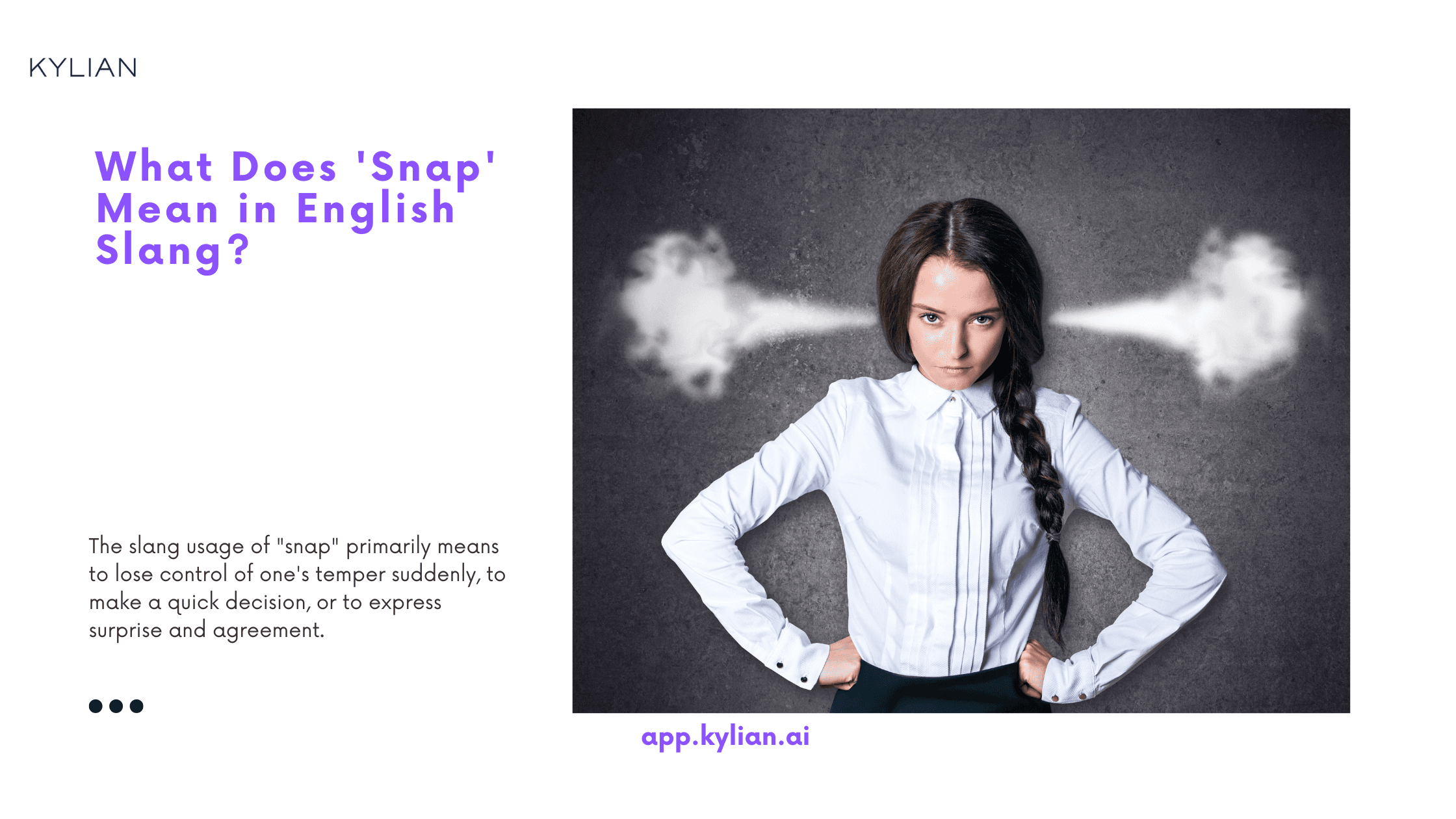
You've encountered native English speakers using "snap" in conversations, but the meaning seems to shift depending on context. This linguistic complexity isn't accidental—"snap" represents one of English's most versatile slang expressions, carrying meanings that extend far beyond its basic definition of breaking or making a sharp sound.
The slang usage of "snap" primarily means to lose control of one's temper suddenly, to make a quick decision, or to express surprise and agreement. Understanding these distinctions matters because misusing "snap" can completely alter your intended message, potentially creating awkward misunderstandings in both professional and casual settings.
In What Context is 'Snap' Used?
The versatility of "snap" emerges through three distinct contextual applications, each carrying specific connotations that native speakers intuitively understand but rarely explain explicitly.
The emotional outburst context represents the most common usage. When someone "snaps," they've reached their psychological breaking point and reacted explosively. This isn't mere anger—it's the culmination of accumulated stress or frustration that manifests as sudden, often disproportionate behavior. The psychological weight behind this usage explains why native speakers treat it seriously rather than casually.
For example: "After months of overtime and no recognition, Sarah finally snapped at her manager during the team meeting." This translates to Sarah losing her composure and likely speaking harshly or inappropriately due to built-up workplace stress.
The decision-making context operates differently, emphasizing speed and decisiveness rather than emotional volatility. Here, "snap" suggests making choices quickly, often based on instinct rather than prolonged deliberation. This usage carries positive connotations of efficiency and confidence.
For example: "When the property became available, Marcus snapped it up within hours." This means Marcus made a rapid purchase decision, likely recognizing a good opportunity.
The expression of surprise or agreement context functions as an interjection, similar to "wow" or "exactly." This usage appears primarily in informal settings and often accompanies finger snapping as a physical gesture. The cultural significance connects to jazz and beatnik traditions where snapping replaced clapping as appreciation.
For example: "Oh snap, I completely forgot about our dinner reservation!" This expresses sudden realization and mild dismay about the forgotten commitment.
How to Use 'Snap' Like a Native Speaker with Examples
The grammatical structures surrounding "snap" reveal sophisticated patterns that distinguish fluent usage from basic understanding. These structures determine meaning and appropriateness across different communicative contexts.
The intransitive verb structure (Subject + snap) typically indicates emotional outbursts or breaking points. This construction requires no direct object because the focus remains on the subject's internal state rather than external actions. The timing aspect proves crucial—"snapping" suggests suddenness rather than gradual change.
For example: "The pressure mounted until she eventually snapped." This sentence structure emphasizes the buildup and sudden release, with "snapped" functioning as a complete predicate.
The transitive verb structure (Subject + snap + object + preposition phrase) applies when discussing quick acquisitions or decisions. This pattern requires direct objects and often includes directional or locational phrases that specify the action's target.
For example: "The investor snapped up the undervalued stocks before the market correction." Here, "snapped up" functions as a phrasal verb with "stocks" as the direct object, indicating rapid acquisition.
The exclamatory structure uses "snap" as an interjection, requiring no grammatical integration with surrounding sentences. This usage often stands alone or appears at sentence beginnings, followed by comma separation from the main clause.
For example: "Snap! That's exactly what I was thinking about the project timeline." The exclamation functions independently, expressing agreement or surprise before transitioning to the main statement.
The conditional and subjunctive structures appear in hypothetical scenarios, particularly when discussing potential breaking points or decision-making thresholds. These constructions often include modal verbs or conditional phrases that establish uncertainty or speculation.
For example: "If the workload increases any further, the entire team might snap under the pressure." This structure uses "might snap" to indicate potential future emotional breakdown based on specified conditions.
4 Other Words You Can Use Instead of 'Snap' to Sound More Natural
Vocabulary variation prevents repetitive language while maintaining precise meaning. These alternatives carry subtle connotational differences that sophisticated speakers leverage strategically.
"Crack" serves as the closest synonym when describing emotional breaking points, but implies more severe psychological damage than "snap." While "snapping" suggests temporary loss of control, "cracking" indicates deeper, potentially lasting psychological impact. This distinction influences usage in serious contexts where the severity of someone's condition matters.
For example: "The constant harassment finally made him crack during the deposition." This suggests more serious psychological consequences than simply "snapping," indicating potential long-term effects requiring professional intervention.
"Flip" replaces "snap" in contexts emphasizing sudden behavioral changes, particularly when the change seems irrational or unexpected. This alternative carries slightly less serious connotations than "snap," making it appropriate for describing surprising but not necessarily concerning behavior changes.
For example: "She completely flipped when she discovered the surprise party preparations." This indicates sudden excitement or joy rather than anger, showing how "flip" can describe positive emotional explosions.
"Seize" substitutes for "snap up" in acquisition contexts, particularly when emphasizing the strategic or opportunistic nature of quick decisions. This alternative adds sophistication to business or investment discussions where "snap" might seem too casual.
For example: "The company seized the acquisition opportunity before competitors could respond." This conveys strategic thinking and business acumen more effectively than "snapped up" in professional contexts.
"Exclaim" works as a formal alternative to exclamatory "snap," particularly in written contexts where interjections need integration into grammatical structures. This substitution maintains the surprise element while elevating register appropriately for academic or professional writing.
For example: "Upon reviewing the data, the analyst exclaimed her agreement with the preliminary findings." This maintains the sudden realization aspect while fitting formal writing conventions.
How to Use 'Snap' in Formal and Informal Scenarios
Context-appropriate usage requires understanding register differences and situational expectations. The formality spectrum influences both word choice and surrounding language patterns.
In corporate performance reviews, "snap" appears when discussing employee stress management and workplace breaking points. This formal context requires careful framing to avoid stigmatizing language while addressing legitimate concerns about employee wellbeing and productivity sustainability.
For example: "Recent project pressures have pushed several team members close to their breaking point, and we've observed instances where individuals have snapped under excessive workloads." This formal usage acknowledges workplace stress without blaming individuals, positioning "snapped" as a predictable response to poor working conditions.
During casual friend gatherings, "snap" functions as emphatic agreement or shared surprise, often accompanied by physical gestures and informal pronunciation patterns. This relaxed context allows for creative usage and playful language experimentation without professional consequences.
For example: "Oh snap, girl! That's the exact same thing that happened to me at my last job interview!" This informal usage combines surprise acknowledgment with emphatic agreement, creating social bonding through shared experience recognition.
In legal depositions or formal testimony, "snap" appears when describing sudden behavioral changes or decision-making processes that require precise temporal documentation. This context demands careful distinction between voluntary actions and involuntary responses to external pressures.
For example: "The defendant's behavior changed dramatically on March 15th, when he snapped and made statements that contradicted his previous testimony." This formal legal usage establishes timeline clarity and behavioral change documentation necessary for legal proceedings.
During family dinner conversations, "snap" serves multiple functions from expressing surprise about relatives' news to describing quick decision-making about household matters. This intimate context allows for emotional expression while maintaining family relationship dynamics.
For example: "Dad just snapped and bought that expensive grill he'd been researching for months." This familial usage suggests impulsive but not necessarily problematic decision-making, adding humor to family financial discussions.
Common Mistakes to Avoid When Using 'Snap'
Pronunciation and timing errors create the most frequent problems for non-native speakers attempting to integrate "snap" naturally into conversations. These mistakes often signal foreign language patterns rather than native fluency.
The first critical error involves using "snap" for gradual processes rather than sudden changes. Native speakers reserve "snap" specifically for abrupt transitions, whether emotional, decisional, or physical. Applying it to slow developments undermines its essential meaning and sounds unnatural to trained ears.
Incorrect example: "Over several months, she slowly snapped under the increasing workload." This misuses "snap" because the process described takes months rather than occurring suddenly.
Correct alternative: "After months of increasing workload, she finally snapped during yesterday's staff meeting." This version preserves the sudden nature essential to "snap's" meaning while acknowledging the gradual buildup that preceded it.
The second major mistake concerns register confusion, particularly using casual "snap" expressions in inappropriate formal contexts. Professional environments require careful consideration of audience expectations and communication objectives.
Incorrect example: "Oh snap! The quarterly projections exceed our initial estimates by thirty percent." This combines casual interjection with formal business reporting, creating tonal inconsistency that undermines professional credibility.
Correct alternative: "Remarkably, the quarterly projections exceed our initial estimates by thirty percent." This maintains surprise and emphasis while respecting professional communication standards and audience expectations.
The Psychology Behind 'Snap' Usage
Understanding the psychological foundations of "snap" reveals why this expression resonates so powerfully across different English-speaking communities. The metaphorical connection between physical breaking and emotional breaking points creates intuitive understanding that transcends cultural boundaries.
Cognitive research demonstrates that sudden behavioral changes often result from accumulated stress reaching critical thresholds. The "snap" metaphor accurately captures this psychological phenomenon where gradual pressure buildup leads to abrupt release. This scientific accuracy explains why the expression feels natural to native speakers and why it effectively communicates complex emotional states.
The neurological basis for "snapping" involves stress hormone accumulation and executive function breakdown. When cortisol levels exceed individual tolerance thresholds, the prefrontal cortex's regulatory capacity diminishes, leading to impulsive behavior that seems out of character. This biological reality makes "snap" an accurate descriptor rather than mere linguistic convention.
Cultural Evolution of 'Snap' in Modern English
The expression's evolution reflects broader cultural shifts in how English speakers discuss mental health, decision-making, and emotional expression. Historical usage patterns reveal changing attitudes toward psychological wellbeing and acceptable emotional displays.
Digital communication has expanded "snap's" usage through social media platforms where brevity and impact determine message effectiveness. The exclamatory "Oh snap!" has gained prominence through viral content and meme culture, reaching global audiences and influencing international English learning patterns.
Professional psychology's influence has legitimized using "snap" in workplace discussions about stress management and employee wellbeing. This therapeutic language adoption reflects growing awareness of mental health issues in professional environments and the need for accessible vocabulary to discuss these topics.
Advanced Usage: Regional and Demographic Variations
Geographic and demographic factors influence "snap" usage patterns across English-speaking regions. These variations affect pronunciation, frequency, and contextual applications that sophisticated speakers navigate instinctively.
American English speakers tend to use "snap" more frequently in business contexts, reflecting cultural comfort with direct communication about stress and decision-making. British English speakers often prefer alternatives like "crack" or "break" in similar situations, reserving "snap" for more extreme circumstances.
Generational differences affect exclamatory usage, with younger speakers embracing "Oh snap!" more readily than older demographics who may perceive it as too casual for their communication preferences. Understanding these patterns helps learners match their usage to their intended audience and social context.
Learn Any Language with Kylian AI
Private language lessons are expensive. Paying between 15 and 50 euros per lesson isn’t realistic for most people—especially when dozens of sessions are needed to see real progress.
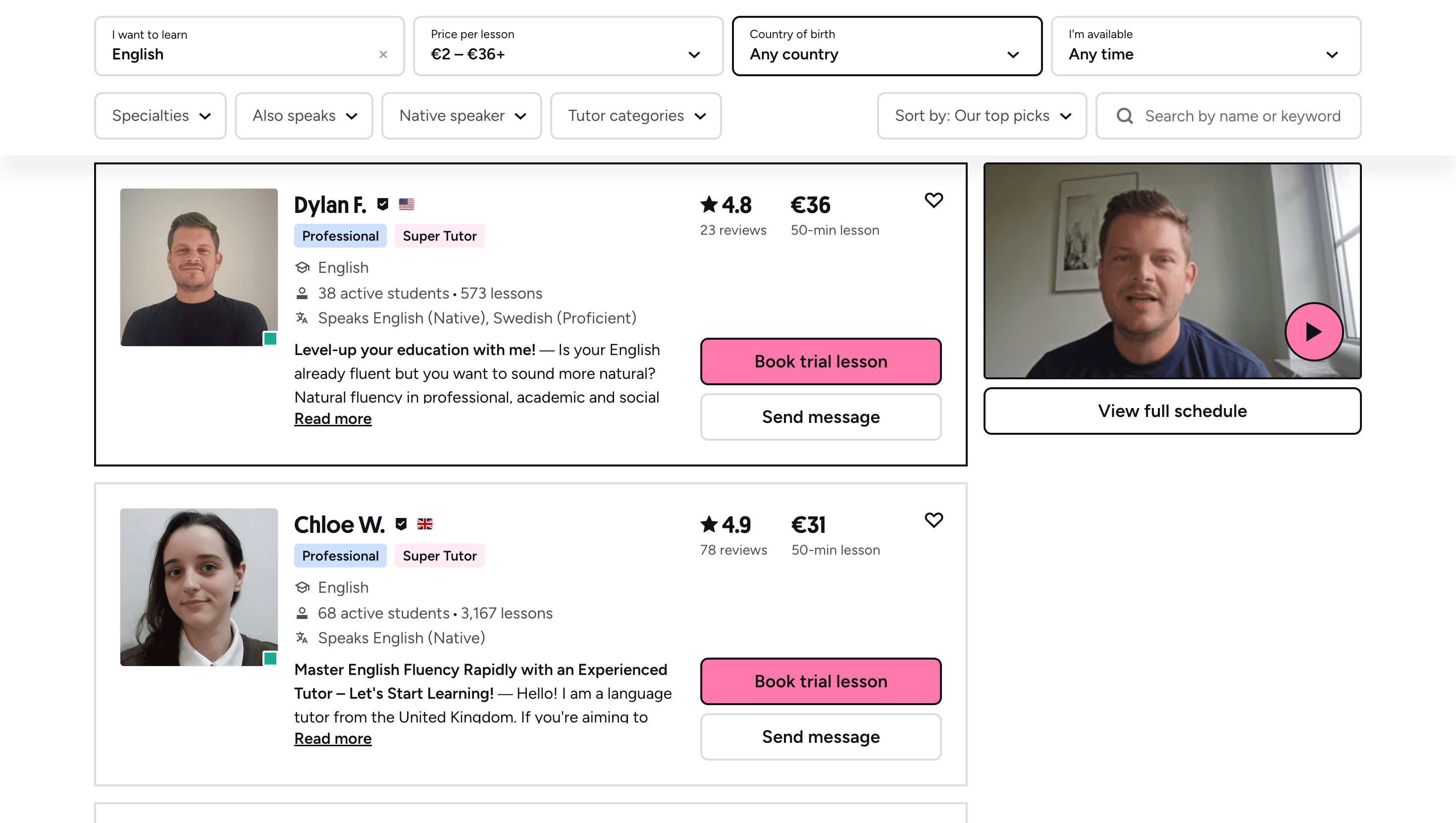
Many learners give up on language learning due to these high costs, missing out on valuable professional and personal opportunities.
That’s why we created Kylian: to make language learning accessible to everyone and help people master a foreign language without breaking the bank.
To get started, just tell Kylian which language you want to learn and what your native language is
Tired of teachers who don’t understand your specific struggles as a French speaker? Kylian’s advantage lies in its ability to teach any language using your native tongue as the foundation.
Unlike generic apps that offer the same content to everyone, Kylian explains concepts in your native language (French) and switches to the target language when necessary—perfectly adapting to your level and needs.
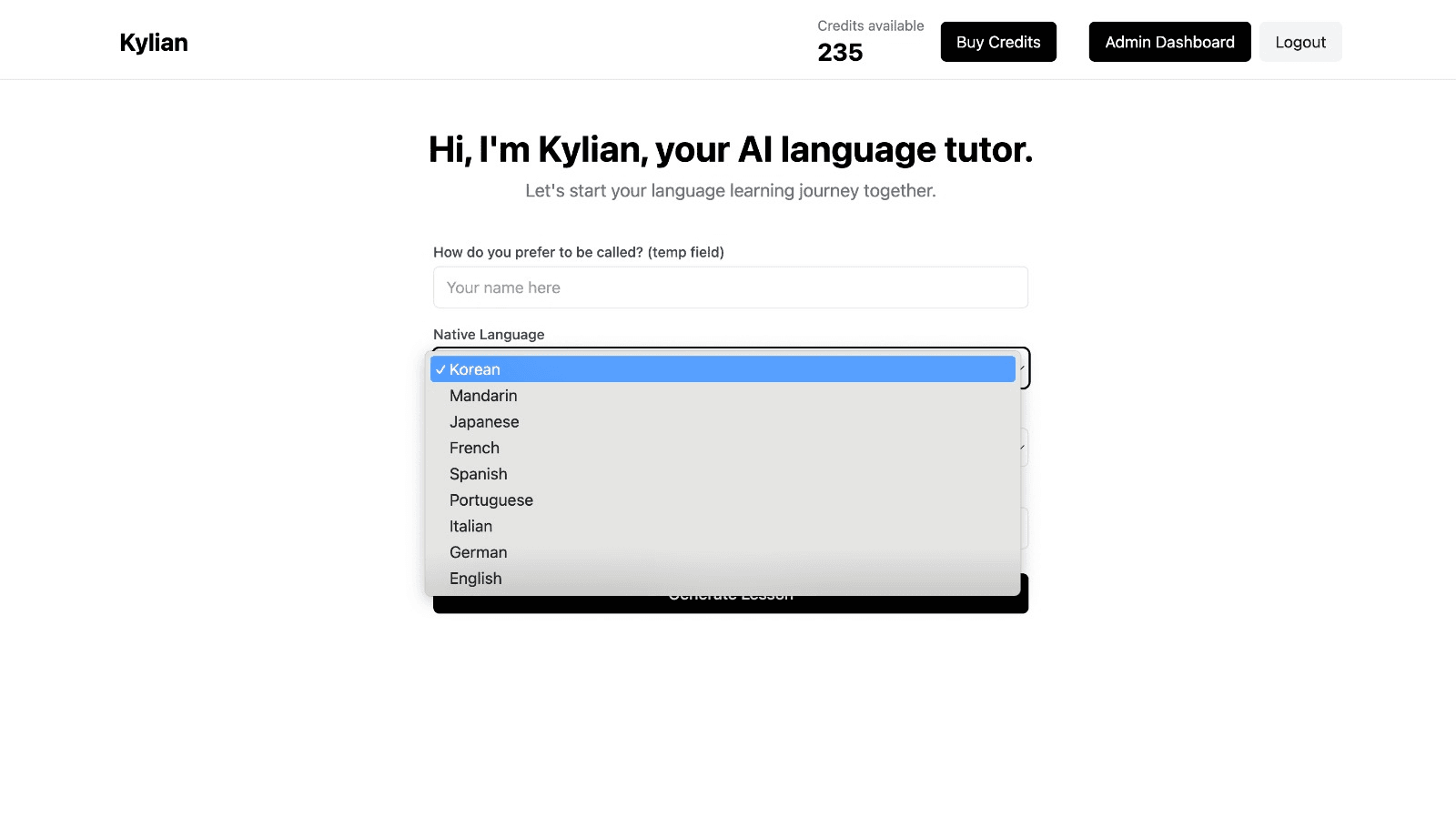
This personalization removes the frustration and confusion that are so common in traditional language learning.
Choose a specific topic you want to learn
Frustrated by language lessons that never cover exactly what you need? Kylian can teach you any aspect of a language—from pronunciation to advanced grammar—by focusing on your specific goals.
Avoid vague requests like “How can I improve my accent?” and be precise: “How do I pronounce the R like a native English speaker?” or “How do I conjugate the verb ‘to be’ in the present tense?”
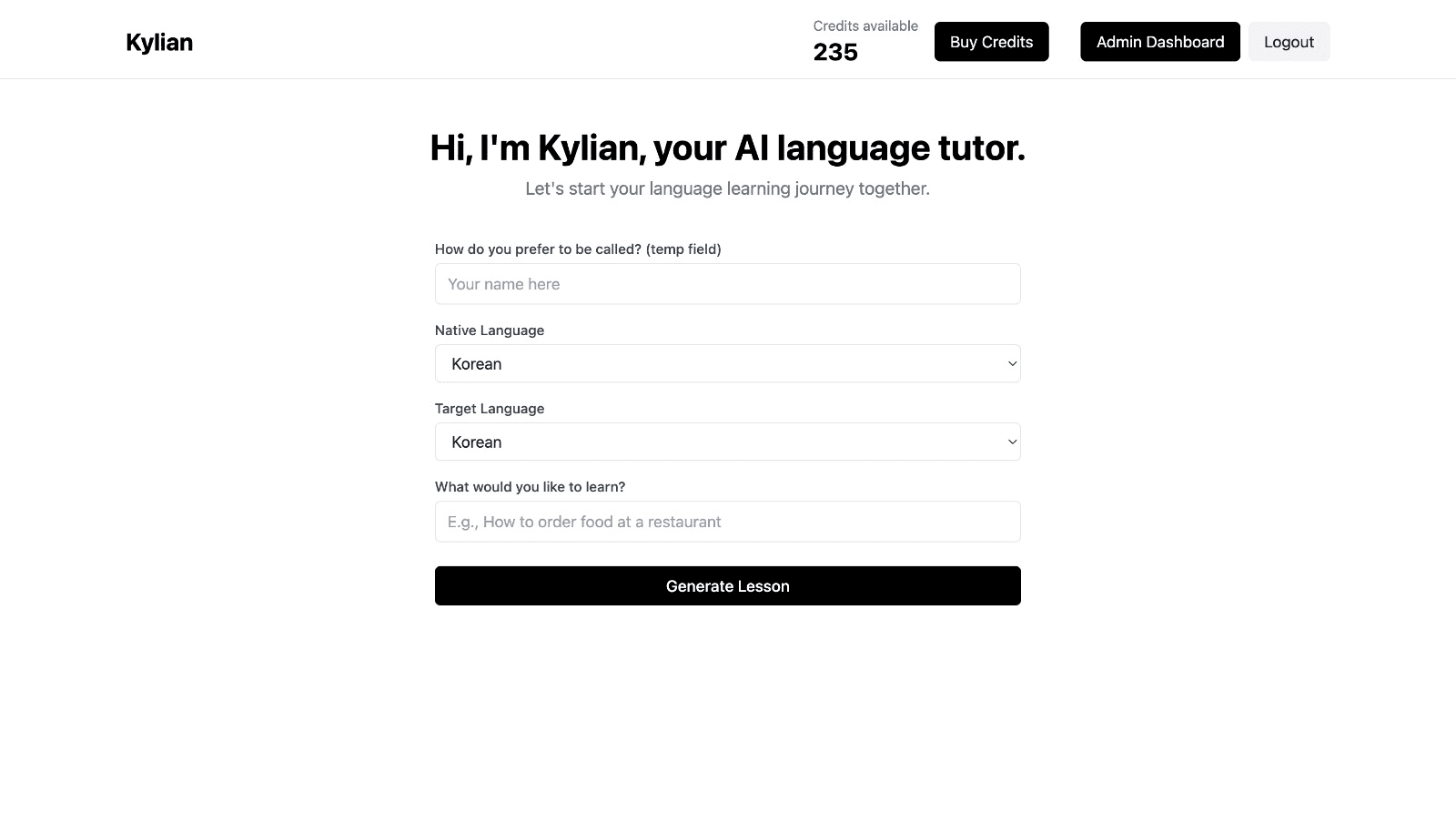
With Kylian, you’ll never again pay for irrelevant content or feel embarrassed asking “too basic” questions to a teacher. Your learning plan is entirely personalized.
Once you’ve chosen your topic, just hit the “Generate a Lesson” button, and within seconds, you’ll get a lesson designed exclusively for you.
Join the room to begin your lesson
The session feels like a one-on-one language class with a human tutor—but without the high price or time constraints.
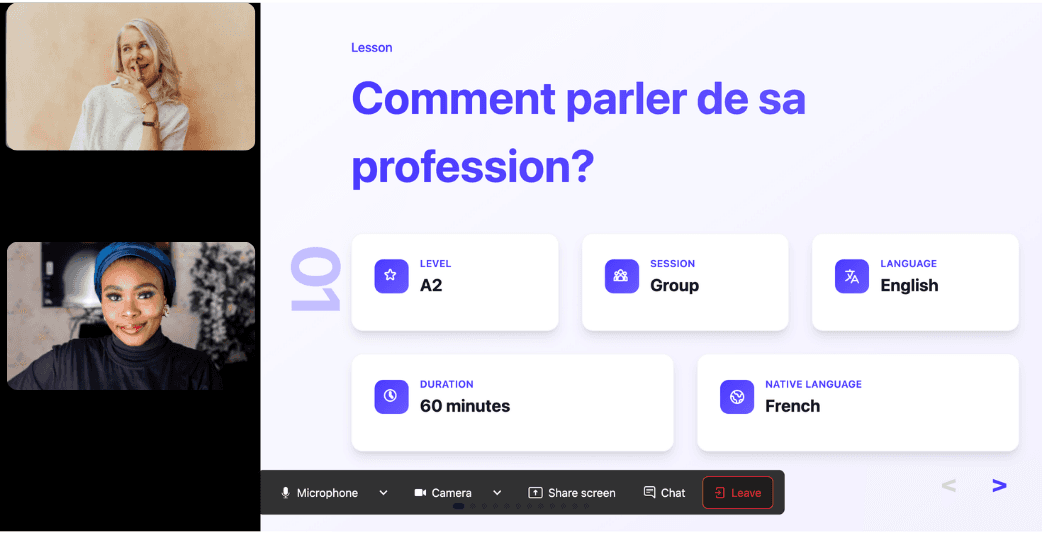
In a 25-minute lesson, Kylian teaches exactly what you need to know about your chosen topic: the nuances that textbooks never explain, key cultural differences between French and your target language, grammar rules, and much more.
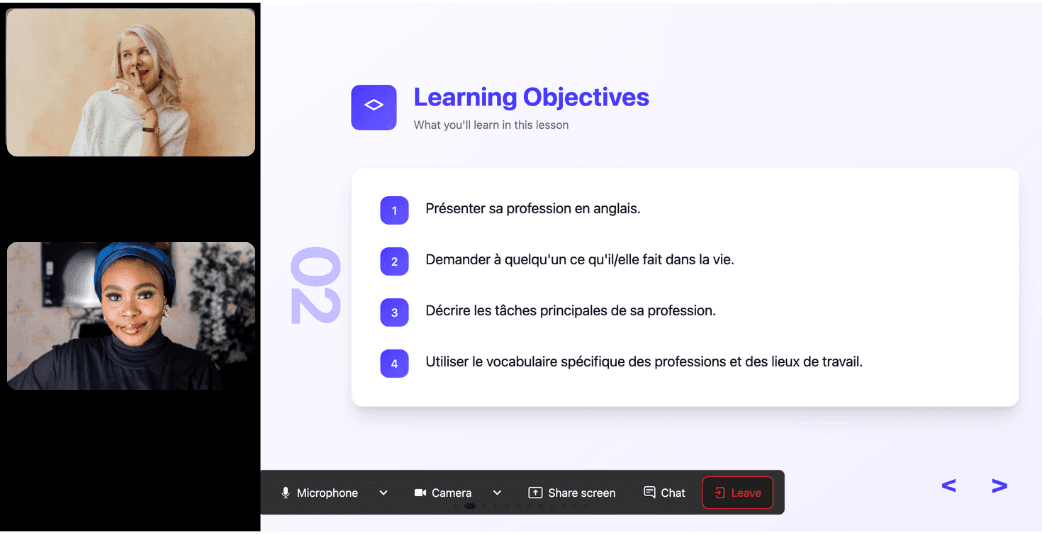
Ever felt frustrated trying to keep up with a native-speaking teacher, or embarrassed to ask for something to be repeated? With Kylian, that problem disappears. It switches intelligently between French and the target language depending on your level, helping you understand every concept at your own pace.
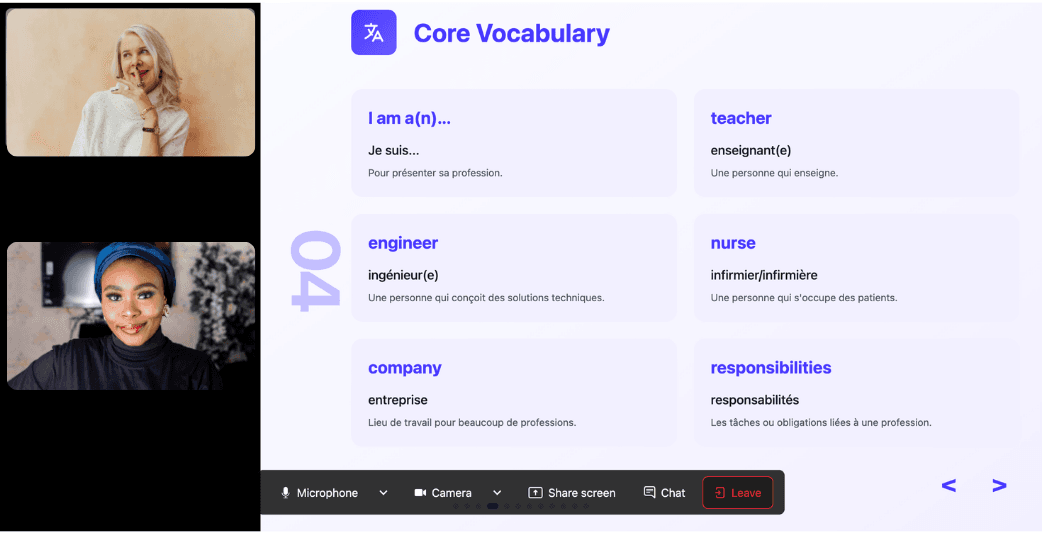
During the lesson, Kylian uses role-plays, real-life examples, and adapts to your learning style. Didn’t understand something? No problem—you can pause Kylian anytime to ask for clarification, without fear of being judged.
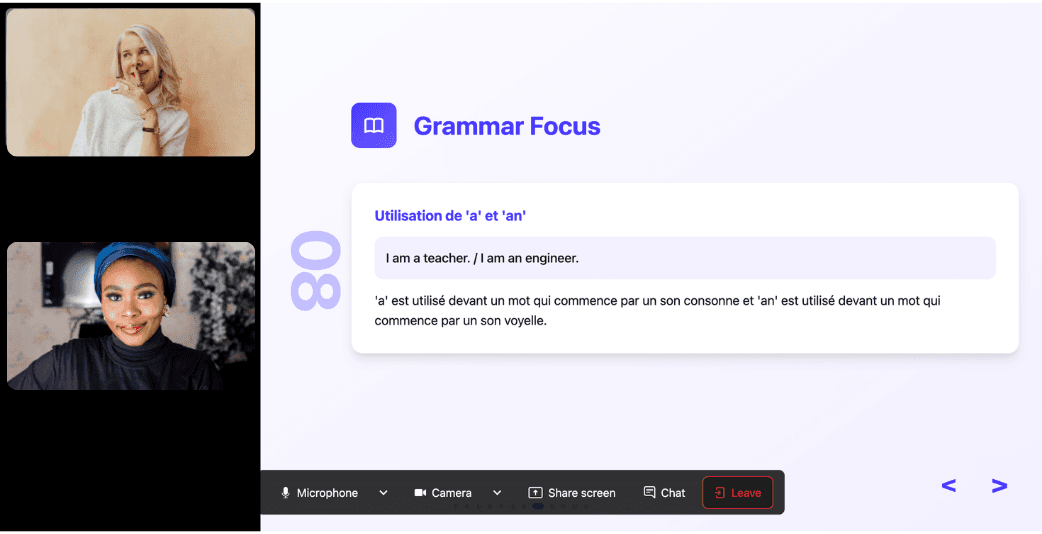
Ask all the questions you want, repeat sections if needed, and customize your learning experience in ways traditional teachers and generic apps simply can’t match.
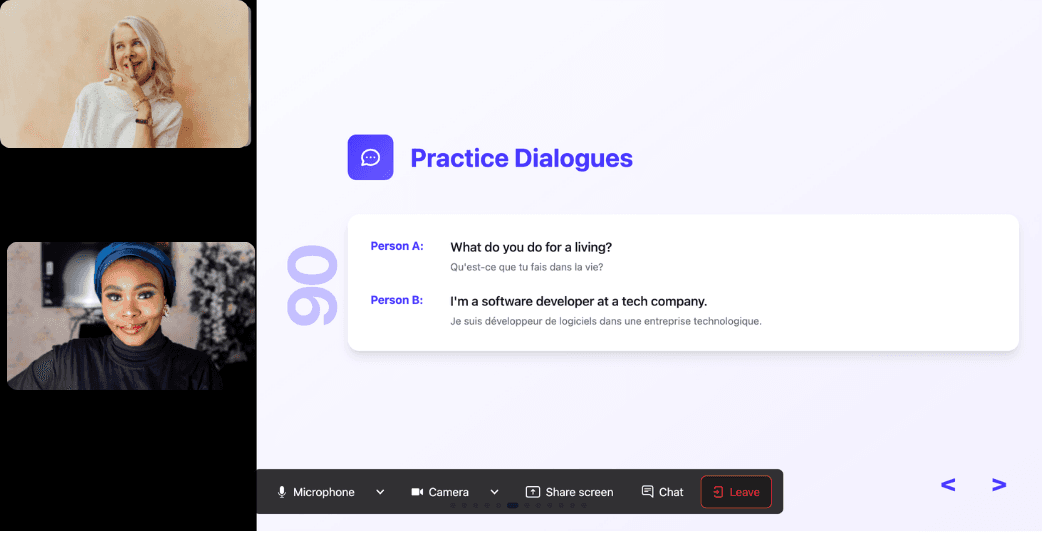
With 24/7 access at a fraction of the cost of private lessons, Kylian removes all the barriers that have kept you from mastering the language you’ve always wanted to learn.
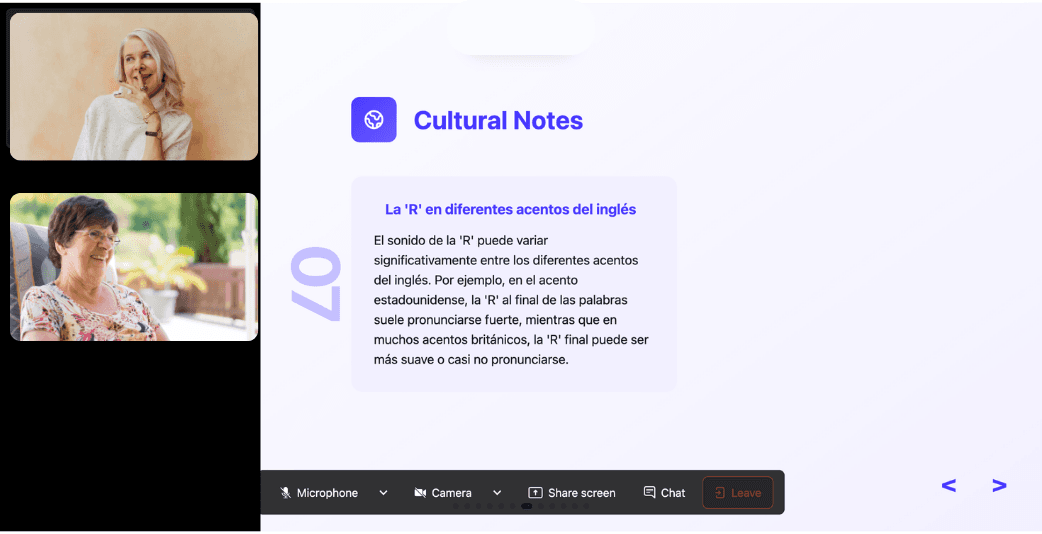
Similar Content You Might Want To Read

What Day Is It Today vs What Day Is Today in English?
Native English speakers often interchange "What day is it today?" and "What day is today?" without giving much thought to their structural differences. Yet these seemingly identical questions reveal fundamental principles about English grammar that affect clarity, formality, and comprehension. Understanding when and why to use each form transforms casual English usage into precise communication. In English, "What day is it today?" follows the standard interrogative structure where the auxiliary verb "is" comes before the subject "it," creating a complete question formation. Meanwhile, "What day is today?" uses a more direct approach, treating "today" as the subject and "what day" as the predicate nominative, resulting in a simplified but equally valid construction.

What is Rain Past Tense in English?
Language evolves through consistent usage, yet fundamental structures like verb tenses remain critical anchoring points for effective communication. The past tense of "rain" represents more than a simple grammatical shift—it embodies how we conceptualize and communicate weather phenomena that have already occurred. Understanding the past tense of "rain" unlocks precision in English storytelling, weather reporting, and everyday conversation. This seemingly straightforward verb actually carries nuanced applications across various contexts, reflecting the complexity embedded in English's temporal expressions. When examining how we reference precipitation that has already fallen, several questions emerge: What forms does the past tense of "rain" take? How do these forms differ in usage and connotation? What common mistakes do English learners encounter, and how can they be avoided? This comprehensive analysis explores the past tense of "rain" from multiple angles, providing clarity for English learners and language enthusiasts alike.

What Is the Past Tense of Catch in English?
The verb "catch" represents one of those fundamental English verbs that appears deceptively simple yet contains nuanced usage patterns that create challenges for language learners. Understanding its past tense forms requires examining both regular patterns in English verb conjugation and the irregular patterns that make "catch" particularly interesting. When we analyze "catch" in its various temporal contexts, we find that its past tense is "caught" - an irregular form that doesn't follow the standard "-ed" pattern of regular verbs. This irregularity creates one of those critical learning moments for English language students where memorization becomes as important as pattern recognition. The question "what is the past tense of catch?" appears straightforward but opens a window into the complexity of English verb tenses and their historical development. Let's dissect this verb systematically to understand not just what forms to use, but why and when to use them.

Just vs. Only: Explaining the difference in English
Grammar precision matters more than most English learners realize. When communication breaks down, it's rarely because someone lacks vocabulary—it's because subtle word choices create unintended meanings. The distinction between "just" and "only" exemplifies this challenge perfectly. These two words appear deceptively simple, yet their misuse can completely alter your intended message. Understanding when to use each word isn't about memorizing rules—it's about grasping the logical framework that governs their application. This distinction becomes particularly critical in professional communication, academic writing, and situations where precision determines outcomes.

Will vs Would: Learn the Difference in English
Modal verbs represent one of the most challenging aspects of English grammar mastery, yet they remain fundamental to effective communication. Among these, will and would create persistent confusion for learners—a confusion that directly impacts clarity and precision in both spoken and written English. The distinction between will and would extends beyond simple grammar rules. These modal verbs carry nuanced meanings that can alter the entire tone and interpretation of your message. Misusing them doesn't just create grammatical errors; it creates communication barriers that can affect professional interactions, academic performance, and everyday conversations. Understanding when to use will versus would becomes critical when you consider that modal verbs appear in approximately 12% of all English sentences, according to corpus linguistics research. This frequency makes mastering their usage essential rather than optional for anyone seeking English proficiency.

Can vs Could: How to Use the Modal Verbs in English
Mastering the distinction between "can" and "could" represents a critical milestone for English language learners. Though frequently used interchangeably in casual conversation, these modal verbs carry subtle but significant differences in meaning, formality, and implication. Understanding these nuances doesn't merely improve grammatical accuracy—it fundamentally enhances communication effectiveness across diverse contexts.